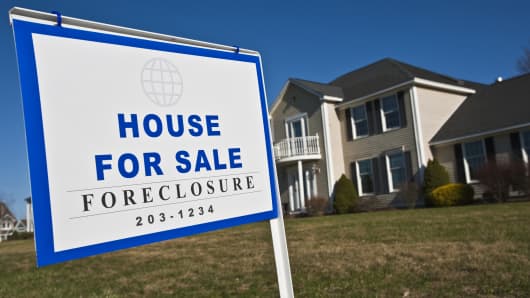Under the proposal
eligible borrowers must be severely underwater, with a loan to value ratio of 125 percent or higher and must be current with their payment. These borrowers would be given current market interest rates, replacing the 6 percent rates they've been unable to refinance out of (because they don't have any equity in the home) and giving them a lower overall monthly payment. The Treasury Department, probably with leftover TARP funds, would pay investors the difference between the old interest rate and the new for five years.
But the American Securitization Forum, which represents investors in residential mortgage backed securities, is balking at the idea, arguing that while underwater borrowers are at greater risk for default it's not clear reducing their monthly payment will change that. It figures $120 billion worth of loan principal would qualify. Taxpayers would kick in $11.5 billion to make up for the reduced interest payments for the first five years and investors would subsequently lose $9.7 billion for the following years.
"The key question from the policy side for both investors and taxpayers is would providing this reduction in monthly interest payments provide any benefit either to the investors or to the public at large by reducing foreclosures? Our answer is we don't think it will appreciably reduce people walking away from their homes," said Tom Deutsch, executive director of ASF.
Investors have been unwilling to reduce interest amountswithout reducing the risk of default. "If they are getting a 6percent interest now, why would they want to turn that into a 3.5 percentif the borrower would still pay the 6%. It would seem wholly irrational toreduce their interest rate if it's not likely to prevent a walk-away borroweror a foreclosure," said Deutsch.
The latest proposal, first reported by the Wall StreetJournal, emerged as part of the "fiscal cliff" negotiations.
Home prices appear to be making a steady recovery, with the latest S&P Case Shiller report showing a 4.3% annual price increase in October on the 20-city composite. A survey of economists by Zillow expects home prices to keep moving up, with expectations for prices to rise 3.1 percent in 2013. But prices are still 30 percent off their June 2006 peak for the 20-city composite. And it's worse in areas hard-hit by the bust. While Phoenix has been a roll for the last year, with prices up 22 percent, prices are still 47 percent below the peak.
Even with higher prices nearly 11 million borrowers still owe more on their mortgage than their home is worth, according to real estate researcher CoreLogic. Many believe it's those homeowners and those with near-negative equity, borrowers who have some equity, but not enough to afford a move, that will keep the housing market from returning to something close to a normal market.


